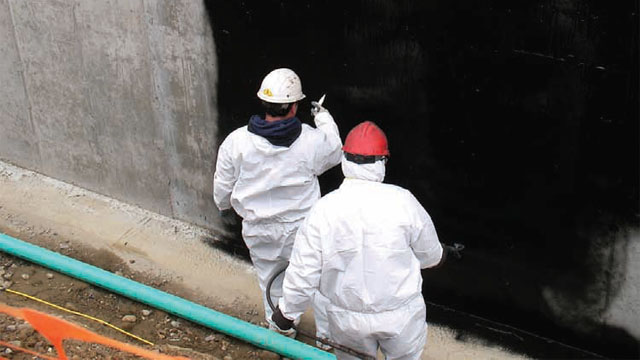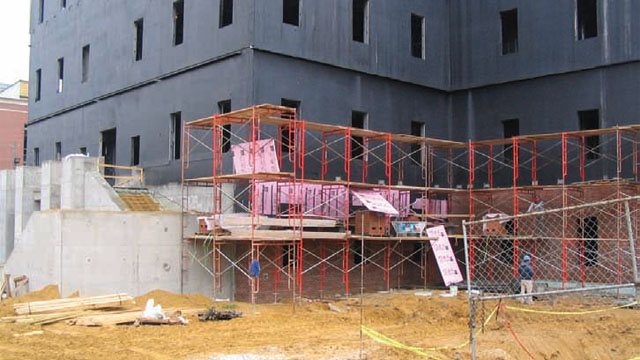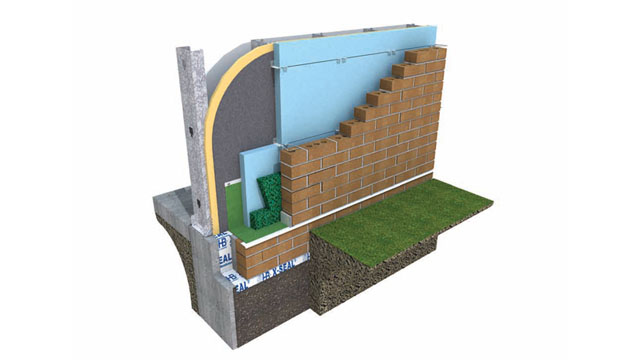July 18, 2011 7:00 AM CDT
Increasing awareness of the importance of the building envelope has occurred due to reports such as the United States Department of Energy’s conclusion that up to 40 percent of energy needed to heat and cool a building is lost from air leakage. State building codes typically reference or adopt ASHRAE Standard 90.1 – Energy Standard for Buildings Except Low-Rise Residential Buildings. The new 2010 version of ASHRAE 90.1 has mandated a 30-percent reduction in building energy usage from its 2004 version. A new understanding is being developed, linking the use of an air barrier system with the proper amount and type of insulation in a wall assembly.
Some of the big changes coming on the horizon include increased “Total Wall R-Value” requirements for many of the eight different climate zones within the United States. In all cases, the air barrier system is going to be a required part of the new code and, in many cases, more insulation will be required to meet the new standards. Another major change will include the requirement for the use of continuous insulation outboard in a metal stud wall assembly. This is being required to minimize the harmful effects of thermal bridging from the metal studs that can carry both hot and cold through the building envelope. But new challenges are arising as wall cavities grow larger to accommodate insulation. The HB-200 HS is an example of the high-strength systems needed to reinforce and anchor the masonry veneer.

Some of the key elements of an effective air barrier system include longevity of the materials involved, plus the ability for the installer to successfully create airtight details. These detail points become the most important aspects of properly functioning wall. These details need to be determined by the architect in the design phase. Most product manufacturers can provide “basic” details but, in many cases, project-specific details must be determined by a team that may include the architect, a consultant and the product manufacturer.
Will the sealant adhere to the detail sheet at door and window openings? Does the window installation detail provide for a total thermal break, plus remain both air and water tight? Will the air barrier material have enough elongation to handle normal building movement, plus maintain its continuity at penetration points such as pipe and duct penetrations, veneer anchor attachments, etc?
As the air barrier industry continues to mature, commercial construction has seen a dramatic growth in the use of fluid-applied barriers, along with self-adhesive tapes. Hohmann & Barnard's Textroflash Liquid and Textroflash Liquid VP combined with X-Seal Transition Membrane are examples of these products. These types of barriers have distinct advantages over previous materials, with an ability to provide total continuity of the barrier, as we know the smallest of gaps can significantly reduce performance.

Self-adhesive systems, like Hohmann & Barnard's Self-Adhering Air and Vapor Barrier, have been popular for many years as well. The factory-controlled thickness is a distinct advantage of these products, and they provide excellent self-sealing characteristics for penetrations. The sheet materials also can span a somewhat larger gap, which can be advantageous when covering sheathing boards if the seams have not been treated in some way. The large majority of self-adhesive sheet systems also are considered to be a vapor barrier in addition to an air barrier.
That leads us to one of the major debates that continue within our industry: “breathable” or “non-breathable.” Some believe all wall systems should be able to breathe and allow vapor transmission through the wall assembly, while others still believe northern climate wall systems with outboard rigid insulation should incorporate a complete air and vapor barrier system. The breathable air barrier actually does not have a specific location within the wall assembly and, in many cases, ease of an effective installation may determine its location. In most cases, no matter the type of barrier system used, the normal placement is on the outer face of CMU or exterior sheathing, which provides the optimum location to create a totally complete and continuous barrier.
As energy efficiency becomes a larger issue, designers and contractors are confronted with more difficult questions regarding air/vapor barriers, detail tapes and flashings, insulation types, sealants, windows and door units, roofing systems, anchoring systems, and mechanical penetrations and their effect on the building envelope. Sound complicated? It sure is, and today, having trusted consultants and industry resource people is becoming more necessary. One thing we all have in common is the desire to create a complete building envelope that functions and performs as intended.
Air Barriers and Insulation
A look at today’s energy-efficient wall assemblies
By Chris Bupp

Metal Stud Wall with “Outsulation” to meet new ASHRAE 90.1 2010 requirement.
The building envelope recently has become a focal point of architects, engineers and a growing number of consultants. The wall assembly now is viewed with the same scrutiny that roofing systems have experienced for many years. In order to make a building energy efficient, and to control moisture infiltration, air/vapor barriers are commonplace on almost all commercial structures today.Increasing awareness of the importance of the building envelope has occurred due to reports such as the United States Department of Energy’s conclusion that up to 40 percent of energy needed to heat and cool a building is lost from air leakage. State building codes typically reference or adopt ASHRAE Standard 90.1 – Energy Standard for Buildings Except Low-Rise Residential Buildings. The new 2010 version of ASHRAE 90.1 has mandated a 30-percent reduction in building energy usage from its 2004 version. A new understanding is being developed, linking the use of an air barrier system with the proper amount and type of insulation in a wall assembly.
Some of the big changes coming on the horizon include increased “Total Wall R-Value” requirements for many of the eight different climate zones within the United States. In all cases, the air barrier system is going to be a required part of the new code and, in many cases, more insulation will be required to meet the new standards. Another major change will include the requirement for the use of continuous insulation outboard in a metal stud wall assembly. This is being required to minimize the harmful effects of thermal bridging from the metal studs that can carry both hot and cold through the building envelope. But new challenges are arising as wall cavities grow larger to accommodate insulation. The HB-200 HS is an example of the high-strength systems needed to reinforce and anchor the masonry veneer.

All air barriers must be totally continuous.
More than ever before, the air barrier system has become a critical part of an energy-efficient wall. Notice that the term “air barrier system” is used, because we have come to learn that not only must the air barrier material be included, but also all related components such as sealants, detail tapes, etc. must be included. All of these components must be compatible with each other, and any adjacent materials in the wall. Single sourcing or complete testing of all the wall components would be a way for designers to develop a level of comfort with all of the related materials. An air barrier system will not serve its intended purpose if careful consideration is given to tying the wall barrier into the roofing system, and also the below-grade waterproofing or even an under slab vapor barrier. We must begin to think of the entire building envelope and the potential for both liquid moisture and vapor diffusion through all four sides of the structure.Some of the key elements of an effective air barrier system include longevity of the materials involved, plus the ability for the installer to successfully create airtight details. These detail points become the most important aspects of properly functioning wall. These details need to be determined by the architect in the design phase. Most product manufacturers can provide “basic” details but, in many cases, project-specific details must be determined by a team that may include the architect, a consultant and the product manufacturer.
Will the sealant adhere to the detail sheet at door and window openings? Does the window installation detail provide for a total thermal break, plus remain both air and water tight? Will the air barrier material have enough elongation to handle normal building movement, plus maintain its continuity at penetration points such as pipe and duct penetrations, veneer anchor attachments, etc?
As the air barrier industry continues to mature, commercial construction has seen a dramatic growth in the use of fluid-applied barriers, along with self-adhesive tapes. Hohmann & Barnard's Textroflash Liquid and Textroflash Liquid VP combined with X-Seal Transition Membrane are examples of these products. These types of barriers have distinct advantages over previous materials, with an ability to provide total continuity of the barrier, as we know the smallest of gaps can significantly reduce performance.

Fluid applied air barriers for concrete and CMU back-up applications.
The newer fluid-applied materials provide a “structural” building envelope barrier with continuous contact to the substrate capable of resisting forces from wind, mechanical pressurization and stack effect. One of the challenges associated with fluid-applied products is the ability to control application thickness, but with more contractors becoming experienced installing the fluid-applied systems, that concern seems to be diminishing. Pre-installation meetings and jobsite inspections are becoming increasingly important to verify proper installation methods. The pre-installation meeting also can determine sequencing of construction, which can determine the best methods for detailing, especially the detail between the wall and roof.Self-adhesive systems, like Hohmann & Barnard's Self-Adhering Air and Vapor Barrier, have been popular for many years as well. The factory-controlled thickness is a distinct advantage of these products, and they provide excellent self-sealing characteristics for penetrations. The sheet materials also can span a somewhat larger gap, which can be advantageous when covering sheathing boards if the seams have not been treated in some way. The large majority of self-adhesive sheet systems also are considered to be a vapor barrier in addition to an air barrier.
That leads us to one of the major debates that continue within our industry: “breathable” or “non-breathable.” Some believe all wall systems should be able to breathe and allow vapor transmission through the wall assembly, while others still believe northern climate wall systems with outboard rigid insulation should incorporate a complete air and vapor barrier system. The breathable air barrier actually does not have a specific location within the wall assembly and, in many cases, ease of an effective installation may determine its location. In most cases, no matter the type of barrier system used, the normal placement is on the outer face of CMU or exterior sheathing, which provides the optimum location to create a totally complete and continuous barrier.
As energy efficiency becomes a larger issue, designers and contractors are confronted with more difficult questions regarding air/vapor barriers, detail tapes and flashings, insulation types, sealants, windows and door units, roofing systems, anchoring systems, and mechanical penetrations and their effect on the building envelope. Sound complicated? It sure is, and today, having trusted consultants and industry resource people is becoming more necessary. One thing we all have in common is the desire to create a complete building envelope that functions and performs as intended.
Originally published in Masonry magazine.
About the Author
Chris Bupp is architectural and educational service director for Hohmann and Barnard.


















